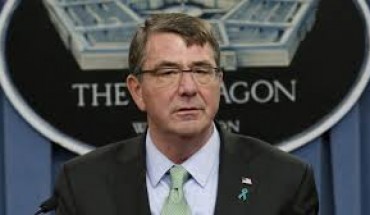WASHINGTON — American Special Operations forces mounted a rare raid into eastern Syria early Saturday, killing a leader of the Islamic State and about a dozen militant fighters, as well as capturing his wife and freeing an 18-year old Yazidi woman whom Pentagon officials said had been held as a slave.
In the first successful raid by American ground troops since the military campaign against the Islamic State began last year, two dozen Delta Force commandos entered Syria aboard Black Hawk helicopters and V-22 Ospreys and killed the leader, Abu Sayyaf. One American military official described him as the Islamic State’s “emir of oil and gas.”
Even so, Abu Sayyaf is a midlevel leader in the organization — one terrorism analyst compared him to Al Capone’s accountant — and likely is replaceable in fairly short order. And the operation, while successful, comes as the Islamic State has been advancing in the Iraqi city of Ramadi, demonstrating that the fight against the Sunni militant group in both Iraq and Syria remains very fluid.
Yet the Pentagon’s description of a nighttime raid that found its intended target deep inside Syria without any American troops being wounded or killed illustrates not only the effectiveness of the Delta Force, but of improving American intelligence on shadowy Islamic State leaders.
A Defense Department official said Islamic State fighters who defended their building and Abu Sayyaf tried to use women and children as human shields, but that the Delta Force commandos “used very precise fire” and “separated the women and children.” The official said that the operation involved close “hand-to-hand fighting.” (The accounts of the raid came from military and government officials and could not be immediately verified through independent sources.)
 The American forces eventually entered the building where they found Abu Sayyaf and his wife, Umm Sayyaf, in a room together. His spouse was captured and later moved to a military facility in Iraq, officials said.
The American forces eventually entered the building where they found Abu Sayyaf and his wife, Umm Sayyaf, in a room together. His spouse was captured and later moved to a military facility in Iraq, officials said.
The raid came after weeks of surveillance of Abu Sayyaf, using information gleaned from a small but growing network of informants the C.I.A. and the Pentagon have painstakingly developed in Syria, as well as satellite imagery, drone reconnaissance and electronic eavesdropping, American officials said. The White House rejected initial reports from the region that attributed the raid to the forces of President Bashar al-Assad of Syria.
“The U.S. government did not coordinate with the Syrian regime, nor did we advise them in advance of this operation,” said Bernadette Meehan, the National Security Council spokeswoman. “We have warned the Assad regime not to interfere with our ongoing efforts against ISIL inside of Syria,” she added, using another name for the Islamic State, which is also known as ISIS.
In a statement early Saturday, Defense Secretary Ashton B. Carter said the killing of Abu Sayyaf dealt a “significant blow” to the group. The militant leader was said to be involved in the Islamic State’s military operations and helped direct its “illicit oil, gas and financial operations” that raised the funds necessary for the organization to operate. Officials said the raid was approved by President Obama.
Defense Department officials said the Delta Force soldiers carrying out the raid came under fire soon after they landed near a building used by Abu Sayyaf as his residence, in Amr, about 20 miles southeast of Deir al Zour, near the oil facilities that he oversaw for the Islamic State.
The commandos had left Iraq aboard the aircraft, and were soon on the ground in Al Amr, a Defense Department official said. They came under fire, the official said, and fired back, killing around a dozen Islamic State fighters.
“The objective was the building, a multistory building,” the official said. He spoke on condition of anonymity because he was not authorized to speak publicly.
Abu Sayyaf “tried to engage” the commandos, the Defense Department official said, and was shot and killed. The commandos took his wife and the Yazidi woman back to the waiting American aircrafts, which, by then, had sustained a number of bullet holes from the firefight with the Islamic State fighters.
Defense Department officials said only Islamic State fighters had been killed in the mission, and that they had received no reports of civilian casualties. But officials acknowledged they were still gathering information on the raid.
The commandos were back in Iraq with the two women around dawn local time, officials said. They said the American forces were able to seize communications equipment and other materials from the site, which may prove useful in intelligence assessments.
The Yazidi woman, Mr. Carter said, will be reunited with her family as soon as possible. It was unclear on Saturday what will be done with Umm Sayyaf, who, according to Mr. Carter’s statement, is suspected of playing an important role in the group’s activities and “may have been complicit in what appears to have been the enslavement” of the Yazidi woman.
The Yazidis are a religious minority persecuted by the Islamic State.
The operation come just months after three unsuccessful raids by American commandos in Syria and Yemen to free American hostages.
In the first one, in Syria last summer, two dozen Delta Force commandos raided an oil refinery in the northern part of the country as part of the effort to free the American journalist James Foley, but found after a firefight that there were no hostages to be saved.
Mr. Foley was later beheaded by the Islamic State.
In the second, on November 25, American Special Operations forces entered a cave near Yemen’s border with Saudi Arabia in an effort to free the American photojournalist Luke Somers. But he was not there; the forces freed eight other hostages and killed seven militants.
A few days later, in December, American forces mounted another attempt to free Mr. Somers, storming a village in southern Yemen, but that raid ended in tragedy with the kidnappers killing Mr. Somers and a South African held with him.
Saturday’s raid into Syria represents an important threshold for the administration in showing that it will continue to send American ground troops into conflicts outside major war zones — as it has in Yemen, Somalia and Libya — to capture or kill suspected terrorists.
Although Abu Sayyaf himself was not a well-known figure, he was important as much for who and what he knew about the Islamic State’s hierarchy and operations, as for his actual job.
“He managed the oil infrastructure and financial generation details for ISIL,” the senior United States official said. “Given that job, he was pretty well connected.”
Bruce O. Reidel, a former C.I.A. analyst now at the Brookings Institution, said the operation looked like “a collection mission, the goal to capture someone or two someones who can explain how ISIS works.” With Abu Sayyaf now dead, he said, “perhaps the wife can do that.”
But, he added: “To me, it demonstrates we still have large gaps in our understanding of the enemy and how it is organized.”
Source: The New york Times

